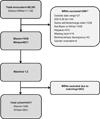Racial disparities in readmission, complications, and procedures in children with Crohn's disease
- PMID: 25742396
- PMCID: PMC4366277
- DOI: 10.1097/MIB.0000000000000325
Racial disparities in readmission, complications, and procedures in children with Crohn's disease
Abstract
Background: Racial disparities in care and outcomes contribute to mortality and morbidity in children; however, the role in pediatric Crohn's disease is unclear. In this study, we compared cohorts of black and white children with Crohn's disease to determine the extent race is associated with differences in readmissions, complications, and procedures among hospitalizations in the United States.
Methods: Data were extracted from the Pediatric Health Information System (January 1, 2004-June 30, 2012) for patients with 21 years or younger hospitalized with a diagnosis of Crohn's disease. White and black cohorts were randomly selected in a 2:1 ratio by hospital. The primary outcome was time from index hospital discharge to readmission. The most frequent complications and procedures were evaluated by race.
Results: There were 4377 patients. Black children had a shorter time to first readmission and higher probability of readmission (P = 0.009) and a 16% increase in risk of readmission compared with white children (P = 0.01). Black children had longer length of stay and higher frequency of overall and late (30-d to 12-mo postdischarge) readmissions (P < 0.001). During index hospitalization, more black children had perianal disease and anemia (P < 0.001). During any hospitalization, black children had higher incidence of perianal disease, anemia, and vitamin D deficiency, and greater number of perianal procedures, endoscopies, and blood product transfusion (P < 0.001).
Conclusions: There are differences in hospital readmissions, complications, and procedures among hospitalized children related to race. It is unclear whether these differences are due to genetic differences, worse intrinsic disease, adherence, access to treatment, or treatment disparities.
Conflict of interest statement
Figures


Comment in
-
African Americans May Access the Emergency Department for Inflammatory Bowel Disease Care More Often than Whites.Inflamm Bowel Dis. 2015 Aug;21(8):E14. doi: 10.1097/MIB.0000000000000481. Inflamm Bowel Dis. 2015. PMID: 26164668 No abstract available.
References
-
- Loftus EV, Jr, Sandborn WJ. Epidemiology of inflammatory bowel disease. Gastroenterol Clin North Am. 2002;31:1–20. - PubMed
-
- Loftus EV., Jr Clinical epidemiology of inflammatory bowel disease: Incidence, prevalence, and environmental influences. Gastroenterology. 2004;126:1504–1517. - PubMed
-
- Benchimol EI, Fortinsky KJ, Gozdyra P, et al. Epidemiology of pediatric inflammatory bowel disease: a systematic review of international trends. Inflamm Bowel Dis. 2011;17:423–439. - PubMed
-
- Malaty HM, Fan X, Opekun AR, et al. Rising incidence of inflammatory bowel disease among children: a 12-year study. J Pediatr Gastroenterol Nutr. 2010;50:27–31. - PubMed
-
- Benchimol EI, Guttmann A, Griffiths AM, et al. Increasing incidence of paediatric inflammatory bowel disease in Ontario, Canada: evidence from health administrative data. Gut. 2009;58:1490–1497. - PubMed
Publication types
MeSH terms
Supplementary concepts
Grants and funding
LinkOut - more resources
Full Text Sources
Medical

